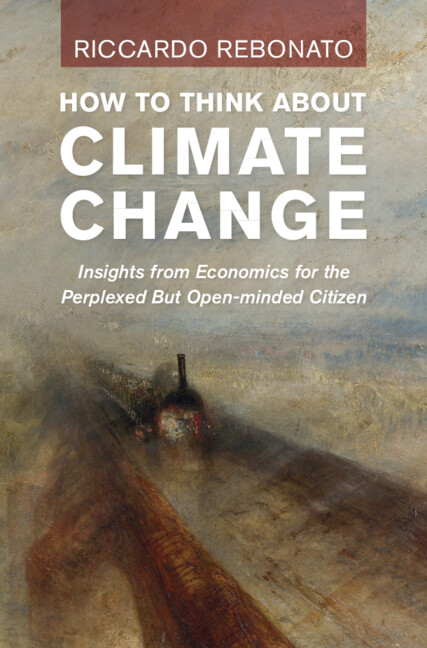
Open-minded citizens who are concerned about the potential impact of global warming on their lives, and on those of their children, are bombarded with wildly discordant information and recommendations. Perhaps few still doubt whether global temperatures are indeed increasing, but, beyond this minimal level of agreement, there remain conflicting, and often strident, views about virtually every other aspect of this phenomenon: whether it is anthropogenic; how severe its effect may be; whether it is too late do something about it; whether we should focus more on abatement or on adaptation; whether we are truly in a ‘climate emergency’; and so on. I intend to show that the analytical tools provided by economics can help the interested layperson reach her own conclusions about how we should tackle the policy challenges posed by climate change.
This is a tall order. With good reasons, laypeople do not ‘trust’ economics as they trust, say, physics or biology. Yet, for all its limitations, economics provides not just a useful, but an indispensable, tool to think about what we should do to limit global warming. This is because at the heart of the ‘climate-change problem’ there are at least three features that are the bread-and-butter of economic analysis: how to allocate scarce resources most efficiently; how to remedy what has been called the greatest negative externality in the history of mankind (which arises from the fact that those who suffer from carbon emissions cannot bargain for compensation); and how to overcome the free-rider problem. Without understanding these three features of climate change no substantive progress can be made in tackling it. And, for better of for worse, economics is the only discipline that deals with these aspects in a coherent way.
The idea that a layperson can profitably look at how we should tackle climate change through the lens of economic analysis is ambitious, but possible. This is because the problem has a factual component (which I present, and about which there should be little disagreement), and an ethical-and-preference component, about which the intelligent reader can express her own views. The economics framework I introduce (without mathematical formulae) then provides the structure to help the readers combine these aspects in a coherent fashion. My goal in this respect is not to give the readers ready-made answers, but to provide them with the analytical tools to make up their minds in a logical and self-consistent manner.
To do so, I use and discuss the latest-generation Integrated Assessment Models. These are the models economists use to derive the course of action that maximizes global welfare in the presence of the damages inflicted by climate change and of the costs its abatement imply. To understand how these recommendations are arrived at, the reader is introduced to the concept of utility, and to how utilities can account for preferences – in practice, for how we are observed to make choices in daily life.
Having cleared this conceptual ground, I go on to explain the policy recommendations these models offer, and why different models offer different solutions. Relying on these models for policy guidance is not uncontroversial. Indeed, these models have been harshly criticized for being overly reductionist; for suggesting too timid a schedule of emission abatement; or for requiring an implausibly altruistic agent in order to recommend a decisive abatement policy. This may have been true for the early generation models. However, more recent developments – developments that incorporate modelling advances that every economist would recognize as desirable – clearly show that we do not need to be ‘infinitely altruistic’ (as the early Stern approach required us to be) to endorse rapid and decisive abatement action. In their modern incarnation, Integrated Assessment Models also show that ‘sharing the climate burden’ via a combination of abatement and removal of CO2 (as virtually all the IPCC pathways compatible with the 1.5-2 C target imply) is far more efficient than relying on abatement only: switching promptly from fossil-fuel to renewable sources of energy remains imperative, but not is neither sufficient, nor efficient. Most importantly, what these new models show is that striving for the Paris-agreement 1.5-2 C maximum end-of-century warming is not just an aspirational goal, but, for reasonable sets of preferences, it is also as an optimal target. The reader can then decide whether these preferences are sufficiently consonant with her own attitudes to risk and to avoiding feast and famine (as they can be gleaned from other observable behaviours and choices) to endorse and make her own the model conclusions.
Admittedly, the economic approach to climate change does fail to deal in a satisfactory manner with many important aspects of the climate problem (first of all, the foreseeable plight of the poorest populations). However, we should heed its policy recommendations of fast and decisive abatement exactly because the approach employed to obtain them is so reductive – by which I mean that those considerations that are poorly accommodated or ignored by cost-benefit analysis, if somehow included, would only make the most desirable policy even more decisive. In the book I do not discuss only the theoretical aspect of the problem, but I deal with a variety of implementation issues, such as the choice between CO2 abatement and removal; whether curbing, or, as some commentators have suggested, even reversing the path of economic growth is a realistic option to limit global warming; or the role of the markets and finance in the green transition. I do so while keeping the economics-based perspective that informs the book.

How To Think About Climate Change by Riccardo Rebonato
Latest Comments
Have your say!